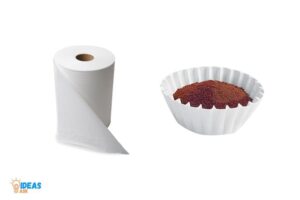Water Moving Up into a Paper Towel is Attributable to!
Water moving up into a paper towel is attributable to capillary action.
Capillary action is a phenomenon that occurs when a liquid, like water, moves through small spaces, like those between the fibers of a paper towel, due to the forces of adhesion, cohesion, and surface tension. This movement defies gravity and allows the liquid to travel upwards through the porous material.
In the case of a paper towel, the fibers of the material create narrow spaces, or capillaries, through which water can move.
The adhesive forces between the water molecules and the fibers cause the water to spread out along the fibers, while cohesive forces between the water molecules make them stick together and resist separation.
Additionally, the surface tension of the water causes it to rise and move upwards against gravity. This combination of forces results in the capillary action that we observe when a paper towel absorbs water.
5 Factors of Water Movement in a Paper Towel
| Factor | Explanation |
|---|---|
| Capillary action | The process by which water is drawn up into small spaces, such as the spaces between paper towel fibers, due to the attraction between the water molecules and the surfaces of the fibers. |
| Adhesion | The force of attraction between water molecules and the paper towel fibers, causing the water to “stick” to the fibers and move upwards. |
| Cohesion | The attractive force between water molecules that allows them to stay together as they move upward through the paper towel. |
| Surface tension | The elastic-like property of the water’s surface that allows it to resist external pressure and helps in the upward movement of water in the paper towel. |
| Gravity | Although gravity works against the upward movement of water, the other forces (capillary action, adhesion, cohesion, and surface tension) are strong enough to overcome gravity and allow water to move upwards. |
Key Takeaway

Five Facts About Water Movement in a Paper Towel
The Properties Of Water And Adhesion
Explanation Of The Behavior Of Water Molecules
Water molecules are made up of two hydrogen atoms and one oxygen atom, which bond together through a covalent bond.
Due to the electrons’ distribution, the oxygen atom has a slightly negative charge whereas hydrogen atoms have a slightly positive charge.
This results in the creation of a polar molecule that attracts other polar molecules. Water’s unique behavior can be attributed to its cohesive and adhesive properties.
The Role Of Hydrogen Bonds In Water Adhesion
Hydrogen bonds play a vital role in water adhesion. These bonds occur due to the attraction between the positively charged hydrogen atoms of one water molecule and a negatively charged oxygen atom of another water molecule.
This attraction forms a weak bond that causes water molecules to stick to each other and to other surfaces, such as paper towels.
How Adhesion Helps Water Climb Up Fibers
Water’s ability to adhere to surfaces contributes to its ability to climb up fibers. When liquid water comes into contact with a surface, it tends to spread out. In the case of paper towels, the fibers in the towel create many small spaces to which water molecules can bond.
This surface area provides support for the water molecules allowing it to move against the force of gravity. Capillary action occurs when adhesion is in play, and the water molecules are pulled up into the paper towel fibers mimicking a suction effect.
This action gives us the ability to absorb fluids with a single swipe.The unique properties of water molecules allow them to bond together and with other surfaces, making water capable of climbing up fibers.
This essential characteristic that is so common to our daily lives even provides us with a convenient way to clean up spills with our paper towels.
Capillarity
Water moving up into a paper towel is attributable to capillarity
Have you ever wondered how water can move up into a paper towel, seemingly defying gravity? The answer is capillarity. This phenomenon is not only responsible for water climbing up fibers but also plays a critical role in several natural and engineering processes.
In this section, we’ll define capillarity, explain how it works as a driving force, and explore its role in water climbing up fibers.
Definition Of Capillarity
Capillarity is the ability of a liquid to flow in narrow spaces without the help of external forces, such as gravity. This phenomenon occurs due to the combination of intermolecular forces and the surface tension of the liquid.
When a liquid comes into contact with a solid surface that it can wet, the liquid molecules experience a net downward force due to their attraction to the solid.
These downward forces balance with the upward forces exerted by the surface tension of the liquid, causing it to rise up into the narrow space, like a capillary tube or a fiber.
Explanation Of Capillary Action As A Driving Force
Capillary action is the driving force behind capillarity. This phenomenon is driven by the adhesive forces between the liquid molecules and the solid surface, and the cohesive forces between the liquid molecules themselves.
When a liquid comes into contact with a solid surface that it can wet, the adhesive forces between the liquid molecules and the solid surface pull the liquid upwards, generating a meniscus.
As the liquid rises, the cohesive forces between the liquid molecules pull the surrounding liquid upwards, creating a suction-like effect. This process continues until the adhesive and cohesive forces are balanced and the liquid reaches its equilibrium height.
The Role Of Capillarity In Water Climbing Up Fibers
When a paper towel comes into contact with water, the water molecules adhere to the fibers of the paper towel. The adhesive forces between the water molecules and the fiber molecules are greater than the cohesive forces between the water molecules themselves.
As a result, the water molecules move up the fibers of the paper towel, defying gravity, through capillary action. This process is why paper towels are effective at absorbing water.
Capillarity is a fascinating phenomenon that allows liquids to flow in narrow spaces without the help of external forces. Capillary action is the driving force behind capillarity, and it plays a critical role in several natural and engineering processes.
Specifically, capillarity is responsible for water climbing up fibers and is why paper towels are effective at absorbing water. Next time you use a paper towel, take a moment to appreciate the wonders of capillarity.
Measuring Capillarity
Methods Used To Measure Capillarity
Capillarity is the phenomenon where a liquid rises in a narrow tube or pathway, defying gravity due to adhesive, cohesive, and surface tension forces.
It occurs in many natural settings, including plants, rocks, soil, and even your home’s paper towels. Measuring capillarity can help us understand these processes better and inform applications such as fluid transport in micro-devices.
The following are some of the methods used to measure capillarity:
- Capillary rise method: Arguably the simplest and easiest method of measuring capillarity, this involves dipping a thin glass tube into a liquid and observing how high the liquid rises due to capillary action. The height of the liquid rise is proportional to the surface tension, tube radius, and contact angle with the liquid.
- Pore size distribution: This technique involves measuring the distribution of pore sizes in a solid material and the volume of fluid that each pore can hold through capillary forces. By using methods such as mercury intrusion porosimetry or gas adsorption, we can obtain an image of the internal pore structure and understand how capillarity operates within the material.
- Contact angle method: This method is useful for determining the wetting behavior of a fluid on a solid surface and how capillary forces play a role in surface interactions. By placing a droplet of fluid on a surface and measuring the angle formed between the droplet and surface, we can calculate the capillary pressure in the droplet and surface energy of the material.
Examples Of Materials In Which Capillarity Is Measured
Capillarity can be measured in various materials and substances, from simple fluids to complex porous media.
Here are some examples of where capillarity is commonly observed and measured:
- Soil science: Capillarity has a considerable influence on soil’s hydraulic properties, such as water storage, infiltration, and drainage. Scientists can measure capillary action in soils by measuring water flow dynamics, moisture content, and pressure head.
- Pharmaceuticals: Capillary forces play a role in drug formulation and the release of drugs from dosage forms. Scientists use techniques such as contact angle measurement and capillary electrophoresis to understand drug-surface and intermolecular interactions
- Building materials: Materials such as concrete, wood, and masonry are porous and can exhibit capillary behavior when exposed to water or air. Understanding capillarity in these materials is critical for building design and protection against moisture damage.
How Measuring Capillarity Helps Understand The Phenomenon
Measuring capillarity can provide valuable insights into the physics and underlying mechanisms of various natural phenomena.
Some of the ways measuring capillarity helps us understand the phenomenon include:
- Plant water transport: Capillary forces play a crucial role in the movement of water within plants. Understanding the capillary pressure gradient helps us comprehend how plants distribute water, which is essential for agricultural management and climate modeling.
- Fuel cells: Capillary action is used in fuel cell design to ensure that reactant gases and electrolyte stay in contact for efficient energy production. Measuring capillary action helps us understand how these processes occur and how to improve the fuel cell’s efficiency.
- Microfluidics: Capillary forces are predominant in microfluidics, where fluids are transported through tiny channels and microchannels. Measuring capillarity helps us understand how fluids behave in these structures and design more effective microfluidic devices.
How Fiber Composition Influences The Phenomenon
Water moving up into a paper towel is attributable to – how fiber composition influences the phenomenon
Have you ever wondered why water moves up into a paper towel? It is a natural phenomenon called capillary action, which occurs due to water’s cohesive and adhesive properties.
Along with these properties, fiber composition also has a significant influence on capillary action. Let’s take a closer look at how fiber composition impacts the phenomenon.
Explanation Of The Different Types Of Fibers
There are mainly two types of fibers: natural and synthetic.
Let’s explore what makes these fibers different:
- Natural fibers: These fibers originate from plants, animals, and minerals. Some common types of natural fibers include cotton, wool, silk, and jute
- Synthetic fibers: Unlike natural fibers, synthetic fibers are human-made. These fibers are usually made from chemicals used in the production of a wide range of fabrics, including polyester, nylon, and rayon.
How Fiber Composition Influences Capillary Action
The composition of fibers plays a significant role in capillary action.
For example:
- Woven fabrics with tight interlacings have less space for water molecules to pass through, which results in slower capillary action. In contrast, fabrics with loosely interlaced fibers have more space, resulting in faster capillary action.
- The diameter of the fibers also determines the capillary action. The smaller the diameter, the higher the capillary action.
Examples Of Fibers That Enhance Capillary Action
Here are some fibers that actively enhance capillary action:
- Cotton: Cotton fibers have a relatively small diameter, making them effective in capillary action. They’re widely used in the production of paper towels, drawing water from one point to another.
- Wool: Wool fibers are effective in capillary action even when wet, making them ideal for use in absorbent products like diapers, towels, and mats.
- Rayon: Rayon, a synthetic fiber, is highly absorbent and lightweight. It’s used in the production of medical products, feminine hygiene products, incontinence products, and wound care products.
The phenomenon of water moving up into a paper towel is because of capillary action caused by water’s cohesive and adhesive properties. However, fiber composition also plays a crucial role in the process.
By understanding the different types of fibers, how they influence capillary action, and examples of fibers that enhance the process, we can design products that are suited for specific applications.
Real-World Examples
Water moving up into a paper towel is attributable to. . .
Have you ever noticed water moving up into a paper towel? This phenomenon occurs when the water molecules are attracted to the cellulose fibers in the paper towel, defying gravity and moving from low concentration to high concentration.
Let’s dive deeper into this remarkable occurrence and explore its real-world examples, significance, and possible applications in different industries.
Examples Of Water Moving Up Into Paper Towels
- Placing a wet paper towel on a dirty surface results in the towel absorbing the dirt particles.
- When a paper towel is placed on top of spilled liquid, it absorbs the liquid and moves it up the paper towel.
- Water moves up a plant stem from where the roots absorb water to the leaves through a process called transpiration.
The Significance Of This Phenomenon
Understanding the science behind water moving up into paper towels can have important applications in numerous fields.
Here are a few examples:
- Agriculture: The concept of transpiration can be applied to optimize irrigation systems and improve crop yield.
- Medicine: The principle of capillary action is important in the movement of water and nutrients in the body. This concept is also useful in designing medical devices such as microfluidics, which mimic capillary action movements.
- Engineering: The study of capillary action is crucial in the design of microfluidic chips for application in drug delivery, medical diagnostics, and biosensing.
Possible Applications In Different Industries
The phenomenon of water moving up into a paper towel has a practical application in various industries, including:
- Household products – paper towels, napkins, and tissues are all products that use capillary action to absorb spills and moisture.
- Laboratories – capillary action is used in chromatography to separate mixtures into their individual components.
- Cosmetics – capillary action is utilized in certain cosmetic products to pull impurities from the skin’s pores.
Call-To-Action
Whether you are a scientist, farmer, or simply an individual who uses paper towels, understanding the fundamental properties of water and how it behaves can have significant practical applications.
The phenomenon of water moving up into a paper towel is just one example of how everyday observations can lead to remarkable discoveries.
FAQ On Water Movement in a Paper Towel
What Causes Water To Move Up A Paper Towel?
Water moves up a paper towel due to capillary action.
Why Does A Paper Towel Absorb Water?
Paper towels absorb water due to their capillary network.
Does The Fold Of A Paper Towel Affect Absorption?
Yes, the fold of a paper towel can affect its absorption rate.
Can Paper Towels Hold More Water Than Their Weight?
Yes, paper towels can hold more water than their weight due to capillary action.
Conclusion
After examining the various reasons why water moves up into a paper towel, we now understand that the phenomenon is attributable to capillary action. This natural force occurs due to the interaction between liquids and the surface tension in the towel’s fibers.
By absorbing the water through the towel’s fibers, capillary action allows excess moisture to be drawn away from surfaces, making paper towels an effective cleaning tool. Understanding the science behind capillary action helps us appreciate the development of everyday products that utilize this incredible natural phenomenon.
Moreover, this knowledge can be put to good use when making decisions about cleaning solutions, or simply in our everyday lives as we observe capillary action in action. So the next time you reach for a paper towel, remember the magic happening as the water moves into it.






